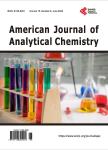Application of NIR Reflectance Spectroscopy on Rapid Determination of Moisture Content of Wood Pellets
Application of NIR Reflectance Spectroscopy on Rapid Determination of Moisture Content of Wood Pellets作者机构:College of Engineering University of Georgia Athens USA National Peanut Research Laboratory Dawson USA Russell Research Center Athens USA
出 版 物:《American Journal of Analytical Chemistry》 (美国分析化学(英文))
年 卷 期:2015年第6卷第12期
页 面:923-932页
主 题:Wood Pellets NIR Reflectance Spectroscopy Moisture Content Partial Least Square Relative Percent Deviation
摘 要:NIR spectroscopy was used to measure the moisture concentration of wood pellets. Pellets were conditioned to various moisture levels between 0.63% and 14.16% (wet basis) and the moisture concentration was verified using a standard oven method. Samples from various moisture levels were separated into two groups, as calibration and validation sets. NIR absorption spectral data from 400 nm to 2500 nm with 0.5 nm intervals were collected using pellets within the calibration and validation sample sets. Spectral wavelength ranges were taken as independent variables and the MC of the pellets as the dependent variable for the analysis. Measurements were obtained on 30 replicates within each moisture level. Partial Least Square (PLS) analysis was performed on both raw and preprocessed spectral data of calibration set to determine the best calibration model based on Standard Error of Calibration (SEC) and coefficient of multiple determinations (R2). The PLS model that yielded the best fit was used to predict the moisture concentration of validation group pellets. Relative Percent Deviation (RPD) and Standard Error of Prediction (SEP) were calculated to validate goodness of fit of the prediction model. Baseline and Multiple Scatter Corrected (MSC) reflectance spectra with 1st derivative model gave the highest RPD value of 4.46 and R2 of 0.95. Also it’s SEP (0.670) and RMSEP (0.782) were less than the other models those had RPD value more than 3.0 with less number of factors. Therefore, this model was selected as the best model for moisture content prediction of wood pellets.



